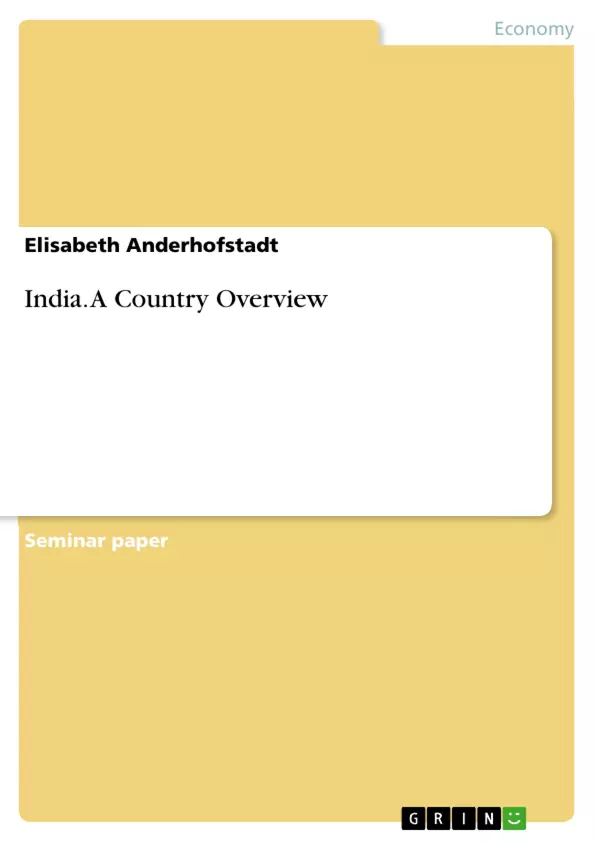In order to summarize the external environment of India, the following report is divided into three parts – the cultural, political and economic issues concerning the country.
India is divided in 28 states as well as in seven territories. The national languages are Hindi and English, but there are about 22 other official languages and nearly 400 living languages spoken in various parts of the country (Global Edge, 2014). India is called a high context culture, which means that their purpose is to maintain harmony. They don’t exchange exact information and the communication in total is less direct than in western cultures. The culture of India is coined by their caste system, where people are being placed in specific groups (Hill, 2014). This determines which types of occupation a person can pursue and also the behavior of one member of society over another (Figure 1). The only chance to escape your current stage in the system is being a good Hindu and being reborn in an upper caste, which reflects the immobility of the social structure in India. Considered as the birthplace of Hindu, 80.5% of the Indian population shares their beliefs (Global Edge, 2014). They believe just in one god with many forms, which means it is a monotheistic religion like Islam and Christianity. Special features are on the one hand that God is considered both, male and female and on the other hand that cows are holy, which means it is forbidden to kill them or eat their meat.
Table of Contents
- 1. Introduction
- 2. Cultural overview
- 3. Political overview
- 4. Economic overview
Objectives and Key Themes
This report aims to provide a summary of the external environment in India, focusing on cultural, political, and economic aspects. The report is structured to offer a concise overview of these key areas.
- Indian Cultural Landscape
- Political Structures and Systems in India
- Economic Overview of India
- Influence of Caste System on Indian Society
- Religious and Cultural Values in India
Chapter Summaries
1. Introduction: This introductory chapter sets the stage for the report by outlining its purpose: to provide a concise summary of the external environment of India, broken down into cultural, political, and economic sections. It establishes the framework for the subsequent chapters, highlighting the interconnectedness of these three areas in shaping India's overall environment. The chapter briefly states that the subsequent sections will delve deeper into each of these aspects.
2. Cultural overview: This chapter delves into the complexities of Indian culture. It begins by highlighting the country's linguistic diversity, noting the existence of Hindi and English as national languages alongside numerous other official and spoken languages. The chapter then emphasizes India's high-context culture, characterized by a strong emphasis on maintaining harmony in communication and a less direct style of interaction compared to Western cultures. A significant portion of the chapter discusses the deeply ingrained caste system, explaining its influence on occupations and social interactions (as illustrated in Figure 1). The enduring impact of Hinduism on the country is also explored, accounting for approximately 80.5% of the population's beliefs and its unique characteristics, including the concept of a monotheistic God with many forms and the sacredness of cows. Finally, the chapter uses Hofstede's five cultural dimensions to analyze different aspects of Indian culture, including power distance, individualism, masculinity, uncertainty avoidance, and pragmatism, offering insights into the cultural values and beliefs shaping Indian society (as shown in Figure 2).
Frequently Asked Questions: Comprehensive Language Preview of India
What is the purpose of this report?
This report aims to provide a concise summary of the external environment in India, focusing on cultural, political, and economic aspects. It highlights the interconnectedness of these areas in shaping India's overall environment.
What topics are covered in the report?
The report covers a range of topics, including: an overview of Indian culture (linguistic diversity, high-context communication, the caste system, Hinduism, and Hofstede's cultural dimensions); an overview of Indian political structures and systems; and an economic overview of India. The influence of the caste system on Indian society and religious and cultural values in India are also discussed.
What is the structure of the report?
The report is structured into chapters: an introduction setting the stage and outlining the purpose; a cultural overview; a political overview; and an economic overview. Each chapter delves deeper into its respective aspect of India's external environment.
What key themes are explored in the cultural overview chapter?
The cultural overview chapter explores India's linguistic diversity, its high-context culture, the deeply ingrained caste system and its influence, the significant impact of Hinduism (including its monotheistic nature with multiple forms of God and the sacredness of cows), and an analysis using Hofstede's five cultural dimensions (power distance, individualism, masculinity, uncertainty avoidance, and pragmatism).
What does the introduction chapter accomplish?
The introduction sets the purpose of the report – to provide a concise summary of India's external environment across cultural, political, and economic sections. It establishes the framework for the following chapters and emphasizes the interconnectedness of these three areas.
What other chapters are included besides the cultural overview?
Besides the cultural overview, the report includes chapters on political and economic overviews of India. These chapters provide summaries of their respective areas in a similar concise manner to the cultural overview.
Where can I find more detailed information on specific aspects of Indian society and culture?
While this report provides a concise overview, further research into specific areas like the caste system, Hinduism, Indian politics, or the Indian economy would require consulting additional sources beyond this summary.
- Quote paper
- Elisabeth Anderhofstadt (Author), 2015, India. A Country Overview, Munich, GRIN Verlag, https://www.grin.com/document/287642



